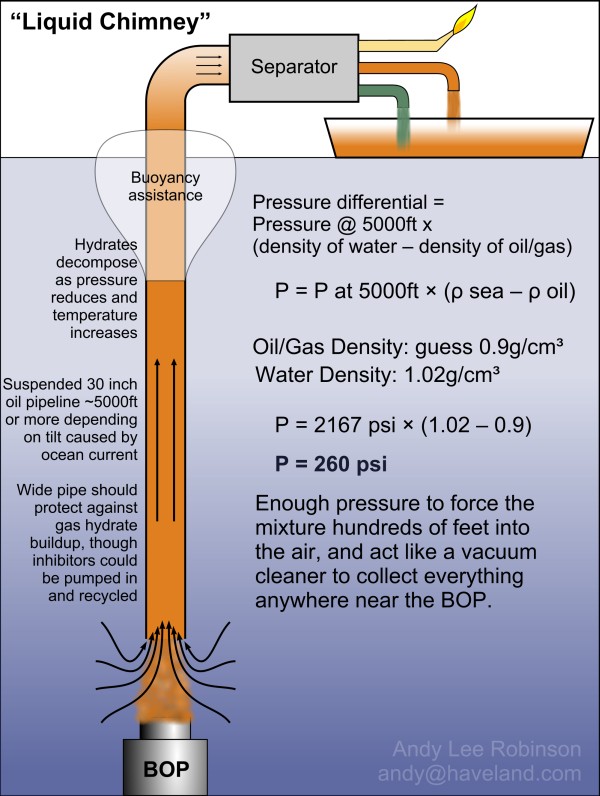Liquid Chimney
An idea to collect all the oil and gas leaking from the blowout preventer using gravity.
Oil is less dense than water, and this can be used in the same way as a chimney removes smoke from a fire as the hot gases are less dense than the surrounding atmosphere.

Suspend a 30-inch diameter oil pipeline over or above the wellhead to act
as a chimney.
As the oil floats up the chimney and fills up, its average density in the
chimney will decrease with respect to the ocean. The ocean will then start to
push the oil to the surface, and the bottom end of the suspended pipeline
will collect the escaping oil just like a vacuum cleaner. It does not have
to form a seal with the wellhead.
Formation of gas hydrates may help, not hinder because they float and are not being forced into a small-diameter pipe, where they can jam. They should decompose near the surface and reduce the density in the pipe still further.
With 5000 feet of draught, there should be enough pressure available to push the oil+gas+water mixture completely out of the ocean and up to a ship, where the pipe contents can be skimmed and separated.
Assuming a full column of oil in the chimney, the pressure at the surface:
Pressure at 5000ft × (density sea – density oil) :
Assuming density of seawater is 1.02 g/cm² and oil at 0.9 g/cm²:
2167 × (1.02 – 0.9) = 260 psi
More than enough to syphon (in the true sense) into a tanker to be separated and recover the oil, however equilibrium would be reached well before the pressure reaches that amount depending on its height out of the water. The contents should pour out at the same rate as it is being collected.
Would need 5-6000 feet of 30-inch welded steel oil pipeline, depending on degree of tilt caused by the ocean current, and a crane to hold tube in place, perhaps with buoyancy compartments to offset weight.
In fact, crane not needed if top of chimney is more buoyant than the total weight. The end of the pipe will just pump out the oil for free.
Assembling the pipeline can be done in parallel at the shore with many welders. The ends can be plugged and the whole length towed to the site. At site, the ends can be unplugged to fill up and allowed to drop near the wellhead.
Countering ocean currents may be difficult with a 30 inch diameter, so might need stays attached to other ships.
Andy Lee Robinson